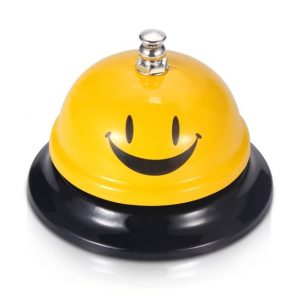Student Contributor: K. Wittkopp
 This tool involves the teacher ringing a bell five times in a row, which signals to students that they should stop what they are doing, look at the teacher, and listen. This tool is helpful because it is a way to get attention without being too loud, and it also gives students time to finish a thought or a sentence before directing their focus to the teacher.
This tool involves the teacher ringing a bell five times in a row, which signals to students that they should stop what they are doing, look at the teacher, and listen. This tool is helpful because it is a way to get attention without being too loud, and it also gives students time to finish a thought or a sentence before directing their focus to the teacher.
When using this tool, the rings should not be too close together. Space them out enough so that students can hear it and have time to focus, but don’t make them so far apart that it takes longer than necessary to quiet down. One important element to keep in mind is the bells are a way to get attention instead of yelling, so do not yell over students if they do not quiet down by the fifth bell. Instead, just sit and wait for students, because the ones that do know what the bells mean will guide the others to quiet down as well.
Personal experience I have had with this tool is that it is effective the more practice it gets. It always depends on classroom climate and the individual students, but if the bells are done often and are reinforced, then students will catch on quickly. Subtle reminders will be necessary for a while, but eventually students will not need to be reminded of what the bells mean.
 I placed this tool specifically in the supportive phase because it occurs during the time when students are learning. It is a way to help them regain their focus while working on a task, and it is also a way for the teacher to gradually gain their attention back if they need to make an announcement or transition the students to the next task. This tool relates to the preventative phase because it can also be used as a transition between tasks. It is a way to have students quiet down rather quickly, and they know that it means they need to listen and await instruction about what is happening next. This tool relates to the corrective phase as well because the teacher can use it during work time to remind the students of what the class should sound like during particular activities (i.e., just a reminder that we are working independently right now so we should be working on our own without help from our peers). Ringing a bell fits in the referent theory of influence the best because it places the responsibility on the students. The teacher rings the bell then just waits for the students to manage themselves and each other to do what they know they are supposed to do when the bell rings.
I placed this tool specifically in the supportive phase because it occurs during the time when students are learning. It is a way to help them regain their focus while working on a task, and it is also a way for the teacher to gradually gain their attention back if they need to make an announcement or transition the students to the next task. This tool relates to the preventative phase because it can also be used as a transition between tasks. It is a way to have students quiet down rather quickly, and they know that it means they need to listen and await instruction about what is happening next. This tool relates to the corrective phase as well because the teacher can use it during work time to remind the students of what the class should sound like during particular activities (i.e., just a reminder that we are working independently right now so we should be working on our own without help from our peers). Ringing a bell fits in the referent theory of influence the best because it places the responsibility on the students. The teacher rings the bell then just waits for the students to manage themselves and each other to do what they know they are supposed to do when the bell rings.
More Information –
Tool Source: Mentor Teacher
https://study.com/academy/lesson/using-bells-in-the-classroom.html


